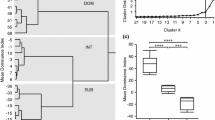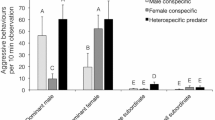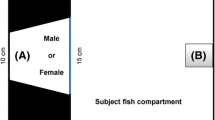Abstract
Agonistic behavior involves the displays that arise when conspecifics compete for valuable resources such as territory. After conflict resolution, dominants obtain priority access to the resource while subordinates lose it. We aimed to evaluate how agonistic encounters mediate the acquisition of different sized territories in the weakly electric fish, Gymnotus omarorum, a species that displays a well-documented non-breeding agonistic behavior very unusual among teleosts. When tested in intrasexual and intersexual dyads in small arenas, a sex-independent dominant-subordinate status emerged after highly aggressive contests in which subordinates signaled submission by retreating and emitting submissive electric signals. We staged dyadic agonistic encounters in a large arena, in which the initial interindividual distance resembled the one observed in nature. We observed the emergence of a dominant-subordinate status after longer but milder contests with rare electric signaling of submission. We found the persistence of dominance over time with no outcome reversion. We observed how dominants exclude subordinates from their conquered resource during all the recording time. Although the territorial behavior of Gymnotus has been put forth since pioneer reports, this is the first study to show how agonistic behavior depends on the territory size in this genus. Agonistic encounters of G. omarorum in the small arena resemble the characteristics of violent-like behaviors. The ease of shifting from mild to high levels of aggression due to confinement, together with the use of electrical signaling of submission, makes this species an excellent model to explore new perspectives in territoriality assessment.




Similar content being viewed by others
References
Adams ES (2001) Approaches to the study of territory size and shape. Annu Rev Ecol Syst 32:277–303
Alexander BK, Roth EM (1971) The effects of acute crowding on aggressive behavior of Japanese monkeys. Behaviour 39:73–90
Armitage KB (1977) Social variety in the yellow-bellied marmot: a population-behavioural system. Anim Behav 25:585–593
Assad C, Rasnow B, Stoddard PK (1999) Electric organ discharges and electric images during electrolocation. J Exp Biol 202:1185–1193
Bakker TCM, Sevenster P (1983) Determinants of dominance in male sticklebacks (Gasterosteus aculeatus L.). Behaviour 86:55–71
Balthazart J, Foidart A, Baillien M, Silverin B (1999) Brain aromatase in laboratory and free-living songbirds: relationships with reproductive behaviour. NJ Adams RH Slotow, pp 1257–1289
Batista G, Zubizarreta L, Perrone R, Silva A (2012) Non-sex-biased dominance in a sexually monomorphic electric fish: fight structure and submissive electric signalling. Ethology 118:398–410
Black-Cleworth P (1970) The role of electrical discharges in the non-reproductive social behaviour of Gymnotus carapo. Anim Behav Monogr 3:1–77
Briffa M, Hardy ICW (2013) Introduction to animal contest. In: ICW H, Briffa M (eds) Animal contest. Cambridge University Press, New York, pp 1–4
Briffa M, Sneddon LU (2010) Contest behavior. In: Westneat DF, Fox CW (eds) Evolutionary behavioral ecology. Oxford University Press, New York, pp 246–265
Brown JL (1964) The evolution of diversity in avian territorial systems. Wilson Bull, pp 160–169
Brown JL (1975) The evolution of behavior. WW Norton, New York
Buchwalder T, Huber-Eicher B (2004) Effect of increased floor space on aggressive behaviour in male turkeys (Meleagris gallopavo). Appl Anim Behav Sci 89:207–214
Caldwell GS, Glickman SE, Smith ER (1984) Seasonal aggression independent of seasonal testosterone in wood rats. Proc Natl Acad Sci 81:5255–5257
Caputi AA, Budelli R (2006) Peripheral electrosensory imaging by weakly electric fish. J Comp Physiol A 192:587–600
Caputi A, Carlson B, Macadar O (2005) Electric organs and their control. In: Bullock TH, Hopkins CD, Popper AN, Fay RR (eds) Electroreception. Springer, New York, pp 410–451
Chiver I, Stutchbury BJM, Morton ES (2014) Seasonal variation in male testosterone levels in a tropical bird with year-round territoriality. J F Ornithol 85:1–9
Ciali S, Gordon J, Moller P (1997) Spectral sensitivity of the weakly discharging electric fish Gnathonemus petersii using its electric organ discharges as the response measure. J Fish Biol 50:1074–1087
Clarke TA (1970) Territorial behavior and population dynamics of a pomacentrid fish, the garibaldi, Hypsypops rubicunda. Ecol Monogr 40:189–212
Crook JH (1965) The adaptive significance of avian social organization. Symp Zool Soc Land 14:181–218
Davies NB (1976) Food, flocking and territorial behaviour of the pied wagtail (Motacilla alba yarrellii Gould) in winter. J Anim Ecol 45:235–253
de Boer SF, Caramaschi D, Natarajan D, Koolhaas JM (2009) The vicious cycle towards violence: focus on the negative feedback mechanisms of brain serotonin neurotransmission. Front Behav Neurosci 3:52. https://doi.org/10.3389/neuro.08.052.2009
de Boer SF, Buwalda B, Koolhaas JM (2016) Aggressive behavior and social stress. In: Stress: concepts, cognition, emotion, and behavior. Elsevier, pp 293–303
Desrochers A, Hannon SJ (1989) Site-related dominance and spacing among winter flocks of Black-capped Chickadees. Condor 91:317–323
Fugère V, Ortega H, Krahe R (2011) Electrical signalling of dominance in a wild population of electric fish. Biol Lett 7:197–200. https://doi.org/10.1098/rsbl.2010.0804
Gómez-Sena L, Pedraja F, Sanguinetti-Scheck JI, Budelli R (2014) Computational modeling of electric imaging in weakly electric fish: insights for physiology, behavior and evolution. J Physiol Paris 108:112–128
Hagedorn M, Carr C (1985) Single electrocytes produce a sexually dimorphic signal in South American electric fish, Hypopomus occidentalis (Gymnotiformes, Hypopomidae). J Comp Physiol A 156:511–523. https://doi.org/10.1007/bf00613975
Hagedorn M, Zelick R (1989) Relative dominance among males is expressed in the electric organ discharge characteristics of a weakly electric fish. Anim Behav 38:520–525
Hau M, Wikelski M, Soma KK, Wingfield JC (2000) Testosterone and year-round territorial aggression in a tropical bird. Gen Comp Endocrinol 117:20–33
Hau M, Stoddard ST, Soma K (2004) Territorial aggression and hormones during the non-breeding season in a tropical bird. Horm Behav 45:40–44
Hazlet BA (1968) Effects of crowding on the agonistic behavior of the hermit crab (Pagurus bernhardus). Ecology 49:573–575
Hopkins CD (1972) Sex differences in electric signaling in an electric fish. Science 176:1035–1037
Hopkins CD (1974) Electric communication: functions in the social behavior of Eigenmannia virescens. Behaviour 50:270–304
Huang W-S, Greene HW, Chang T-J, Shine R (2011) Territorial behavior in Taiwanese kukrisnakes (Oligodon formosanus). Proc Natl Acad Sci 108:7455–7459
Hungtinford F, Turner A (1987) Animal conflict. Chapman and Hall Ltd, London
Hupé GJ, Lewis JE (2008) Electrocommunication signals in free swimming brown ghost knifefish, Apteronotus leptorhynchus. J Exp Biol 211:1657–1667
Hupé GJ, Lewis JE, Benda J (2008) The effect of difference frequency on electrocommunication: chirp production and encoding in a species of weakly electric fish, Apteronotus leptorhynchus. J Physiol Paris 102:164–172
Jalabert C, Quintana L, Pessina P, Silva A (2015) Extra-gonadal steroids modulate non-breeding territorial aggression in weakly electric fish. Horm Behav 72:60–67. https://doi.org/10.1016/j.yhbeh.2015.05.003
Jennions MD, Backwell PRY (1996) Residency and size affect fight duration and outcome in the fiddler crab Uca annulipes. Biol J Linn Soc 57:293–306. https://doi.org/10.1111/j.1095-8312.1996.tb01851.x
Jun JJ, Longtin A, Maler L (2016) Active sensing associated with spatial learning reveals memory-based attention in an electric fish. J Neurophysiol 115:2577–2592. https://doi.org/10.1152/jn.00979.2015
Kaufmann JH (1983) On the definitions and functions of dominance and territoriality. Biol Rev 58:1–20
King JA (1973) The ecology of aggressive behavior. Annu Rev Ecol Syst 4:117–138
Knell RJ (2009) Population density and the evolution of male aggression. J Zool 278:83–90
Kokko H, Rankin DJ (2006) Lonely hearts or sex in the city? Density-dependent effects in mating systems. Phil Trans R Soc B 361:319–334
Lissman H (1958) On the function and evolution of electric organs in fish. J Exp Biol 35:156–191
Lorenz K (1963) On aggression. Harcourt, Brace and World, New York
Maciver MA, Sharabash NM, Nelson ME (2001) Prey-capture behavior in gymnotid electric fish: motion analysis and effects of water conductivity. J Exp Biol 204:543–557
Maher CR, Lott DF (1995) Definitions of territoriality used in the study of variation in vertebrate spacing systems. Anim Behav 49:1581–1597
Maynard Smith J, Parker GA (1976) The logic of asymmetric contests. Anim Behav 24:159–175
Miczek KA, de Almeida RMM, Kravitz EA, Rissman EF, de Boer SF, Raine A (2007) Neurobiology of escalated aggression and violence. J Neurosci 27:11803–11806
Morrell LJ, Kokko H (2005) Bridging the gap between mechanistic and adaptive explanations of territory formation. Behav Ecol Sociobiol 57:381–390
Nelson RJ (2006) Biology of aggression. Oxford University Press, New York
Oldfield R (2011) Aggression and welfare in a common aquarium fish, the Midas cichlid. J Appl Anim Welf Sci 14:340–360
Parker GA, Rubenstein DI (1981) Role assessment, reserve strategy, and acquisition of information in asymmetric animal conflicts. Anim Behav 29:221–240
Pedraja F, Aguilera P, Caputi AA, Budelli R (2014) Electric imaging through evolution, a modeling study of commonalities and differences. PLoS Comput Biol 10:e1003722. https://doi.org/10.1371/journal.pcbi.1003722
Pedraja F, Perrone R, Silva A, Budelli R (2016) Passive and active electroreception during agonistic encounters in the weakly electric fish Gymnotus omarorum. Bioinspir Biomim 11(6):065002. https://doi.org/10.1088/1748-3190/11/6/065002
Pedraja F, Hofmann V, Lucas KM, Young C, Engelmann J, Lewis JE (2018) Motion parallax in electric sensing. Proc Natl Acad Sci 115:573–577
Perrone R, Silva A (2016) Vasotocin increases dominance in the weakly electric fish Brachyhypopomus gauderio. J Physiol Paris 110:119–126
Perrone R, Silva AC (2018) Status-dependent vasotocin modulation of dominance and subordination in the weakly electric fish Gymnotus omarorum. Front Behav Neurosci 12:1
Perrone R, Macadar O, Silva A (2009) Social electric signals in freely moving dyads of Brachyhypopomus pinnicaudatus. J Comp Physiol A 195:501–514
Pröhl H (2005) Territorial behavior in dendrobatid frogs. J Herpetol 39:354–365
Quintana L, Zubizarreta L, Jalabert C, Batista G, Perrone R, Silva A (2016) Building the case for a novel teleost model of non-breeding aggression and its neuroendocrine control. J Physiol Paris 110:224–232
Randall JA (1984) Territorial defense and advertisement by Footdrumming in Bannertail Kangaroo Rats (Dipodomys spectabilis) at high and low population densities. Behav Ecol Sociobiol 16:11–20
Richer-de-Forges MM, Crampton WGR, Albert JS (2009) A new species of Gymnotus (Gymnotiformes, Gymnotidae) from Uruguay: description of a model species in neurophysiological research. Copeia 2009:538–544
Roth E, Zhuang K, Stamper SA, Fortune ES, Cowan NJ (2011) Stimulus predictability mediates a switch in locomotor smooth pursuit performance for Eigenmannia virescens. J Exp Biol 214:1170–1180
Silva A, Quintana L, Galeano M, Errandonea P (2003) Biogeography and breeding in Gymnotiformes from Uruguay. Environ Biol Fish 66:329–338
Silva A, Perrone R, Macadar O (2007) Environmental, seasonal, and social modulations of basal activity in a weakly electric fish. Physiol Behav 90:525–536
Silva AC, Perrone R, Zubizarreta L, Batista G, Stoddard PK (2013) Neuromodulation of the agonistic behavior in two species of weakly electric fish that display different types of aggression. J Exp Biol 216:2412–2420
Sogge MK, Koronkiewicz TJ, van Riper C III, Durst S (2007) Willow flycatcher nonbreeding territory defense behavior in Costa Rica. Condor 109:475–480
Stoddard P (2002) The evolutionary origins of electric signal complexity. J Physiol 96:485–491
Summers CH, Winberg S (2006) Interactions between the neural regulation of stress and aggression. J Exp Biol 209:4581–4589
Triefenbach F, Zakon H (2008) Changes in signalling during agonistic interactions between male weakly electric knifefish, Apteronotus leptorhynchus. Anim Behav 75:1263–1272
Turner SP, Ewen M, Rooke JA, Edwards SA (2000) The effect of space allowance on performance, aggression and immune competence of growing pigs housed on straw deep-litter at different group sizes. Livest Sci 66:47–55
Umbers KD, Osborne L, Keogh JS (2012) The effects of residency and body size on contest initiation and outcome in the territorial dragon, Ctenophorus decresii. PLoS One 7:e47143
Westby G (1975a) Further analysis of the individual discharge characteristics predicting social dominance in the electric fish. Anim Behav 23:249–260
Westby GWM (1975b) Comparative studies of the aggressive behaviour of two gymnotid electric fish (Gymnotus carapo and Hypopomus artedi). Anim Behav 23:192–213
Wilson EO (1975) Sociobiology: The New Synthesis. University Press, Harvard
Wingfield JC, Hahn TP (1994) Testosterone and territorial behaviour in sedentary and migratory sparrows. Anim Behav 47:77–89. https://doi.org/10.1006/anbe.1994.1009
Zakon HH, Thomas P, Yan H-Y (1991) Electric organ discharge frequency and plasma sex steroid levels during gonadal recrudescence in a natural population of the weakly electric fish Sternopygus macrurus. J Comp Physiol A 169:493–499. https://doi.org/10.1007/bf00197661
Zubizarreta L, Perrone R, Stoddard PK, Costa G, Silva AC (2012) Differential serotonergic modulation of two types of aggression in weakly electric fish. Front Behav Neurosci 6(77). https://doi.org/10.3389/fnbeh.2012.0007
Zubizarreta L, Stoddard PK, Silva A (2015) Aggression levels affect social interaction in the non-breeding territorial aggression of the weakly electric fish, Gymnotus omarorum. Ethology 121:8–16
Acknowledgments
We specially thank Laura Quintana and Lucía Zubizarreta for their generous comments and suggestions to our manuscript. We are very grateful to Adriana Migliaro, Carlos Passos, Laura Quintana, Federico Reyes, and Lucía Zubizarreta for their useful discussions during the BERTA Workshop, Cerro del Toro, Piriápolis, Uruguay.
Funding
This work was supported by National Agency for Research and 50 Innovation (ANII), projects FCE 569 and FCE 4272.
Author information
Authors and Affiliations
Corresponding author
Ethics declarations
Electric fish collection for experimental purposes was authorized by DINARA (National Direction of Aquatic Resources) and MGAP (Ministry of Agriculture and Fisheries), resolution No. 065/2004. All experimental procedures complied with ASAP/ABS Guidelines for the Use of Animals in Research and were approved by our institutional ethical committee (Comisión Bioética, Instituto Clemente Estable, MEC, 007/05/2012).
Additional information
Publisher’s note
Springer Nature remains neutral with regard to jurisdictional claims in published maps and institutional affiliations.
Rights and permissions
About this article
Cite this article
Perrone, R., Pedraja, F., Valiño, G. et al. Non-breeding territoriality and the effect of territory size on aggression in the weakly electric fish, Gymnotus omarorum. acta ethol 22, 79–89 (2019). https://doi.org/10.1007/s10211-019-00309-7
Received:
Revised:
Accepted:
Published:
Issue Date:
DOI: https://doi.org/10.1007/s10211-019-00309-7




